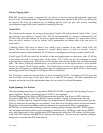Rev. 051208 page 20 of 152
SNMP Traps
The 7014 Series switch supports up to 5 SNMP Trap Stations to which SNMP Traps will be sent. The
switch supports three standard traps; Link Up, Link Down, and Cold Start. SNMP Traps will be sent to all
the stations configured on the switch if a port Link goes up or down, and when the switch first powers up.
IGMP Snooping
IGMP Snooping is enabled by default, and the switch is Plug and Play for IGMP. IGMP snooping provides
intelligent network support for multicast applications. In particular, unneeded traffic is reduced. IGMP
Snooping is configured via the console and if enabled, then operates dynamically upon each power up.
Also, there can be manual only or manual and dynamic operation. Note that “static multicast group
address” can be used whether IGMP Snooping is enabled or not.
IGMP Snooping will function dynamically without user intervention. If some of the devices in the LAN do
not understand IGMP, then manual settings are provided to accommodate them. The Internet Group
Management Protocol (IGMP) is a protocol that provides a way for a computer to report its multicast group
membership to adjacent ‘routers’. In this case N-Tron 7014 series switches provide router-like
functionality. Multicasting allows one computer to send content to multiple other computers that have
identified themselves as interested in receiving the originating computer's content. Multicasting can be used
to transmit only to an audience that has joined (and not left) a multicast group membership. IGMP version 2
is formally described in the Internet Engineering Task Force (IETF) Request for Comments (RFC) 2236.
IGMP version 1 is formally described in the Internet Engineering Task Force (IETF) Request for Comments
(RFC) 1112. The 7014 series supports v1 and v2.
N-Ring
N-Ring is enabled by default, and the switch is Plug and Play for N-Ring except that initially one must
enable an N-Ring enabled device to be the N-Ring Manager for a given N-Ring. Subsequently,
N-Ring operates dynamically upon each power up. Using N-Tron's proprietary N-Ring technology offers
expanded ring size capacity, detailed fault diagnostics, and a standard healing time of 30ms. The N-Ring
Manager periodically checks the health of the N-Ring via health check packets. If the N-Ring Manager
stops receiving the health check packets, it times out and converts the N-Ring to a backbone within 30ms.
When using all N-Ring enabled switches in the ring, a detailed ring map and fault location chart is also
provided on the N-Ring Manager’s web browser. N-Ring status is also sent from the N-Ring Manager to
the N-View OPC Server to identify the health status of the ring. Up to 250 N-Ring enabled switches can
participate in one N-Ring topology. Switches that do not have N-Ring capability may be used in an N-Ring,
however the ring map and fault location chart cannot be as detailed at these locations.


















